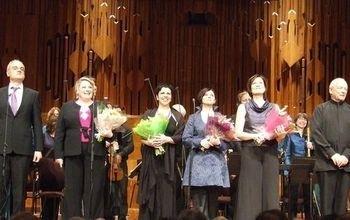Handel - Arianna in Creta (Hogwood) [2009]
Handel - Arianna in Creta (Hogwood) [2009]

(01) act 1 [56'43"] (02) act 2 [1.10'24"] (03) act 3 [42'58"] Lisa Milne, soprano (Alceste) Miah Persson, soprano (Arianna) Kristina Hammarström, mezzo-soprano (Teseo) Marina de Lisa, mezzo-soprano (Tauride) Sonia Prina, contralto (Carilda) Antonio Abete, bass (Minos) The Academy of Ancient Music, Christopher Hogwood – director recorded: May 17, 2009, Barbican Hall, London
On December twenty-ninth, 1733, the Opera of the Nobility opened its doors at Lincoln's Inn Theatre. Backed by the Prince of Wales and his noble cronies, the opera was set up in direct competition to Handel's opera company, which was subsidized by the estranged Prince's father, King George I. Almost all of Handel's singers defected to the new company, and the director's of the Opera of the Nobility also imported a renowned opera seria composer and vocal teacher as their music director. Nicola Porpora, the trainer of some of the finest castrati of the era and a composer of opere serie arrived in London to help run the new company. This was not the first time that Handel had been faced with intense competition. He planned a huge season, and began writing Arianna in Crete as the new opera to be premiered. However the competitive Porpora found out about the opera and opened his season with his own setting of Arianna in Nasso.
Handel hired a new castrati to replace Senesino, for the great star had defected. His new man, Carestini, sang for him from 1733-1735 as the lead in Ariodante and Alcina as well. Durastanti, an old friend of Handel, returned to London, and the prima donna star Strada stayed on with him also. Arianna in Crete premiered in January of 1734 and had a very decent run of fourteen performances. Musically the opera is characterized by the music for Carestini. He had incredible stamina, and could perform concerto-like vocal compositions with comparable ease. He excelled at the driving rhythms and violinistic ornamentation of the Italian concerto style.
The overture to Arianna begins the dramatic action, for the orchestra is still playing when the curtain rises on the dire processions of victims of the minotaur. The story is set in the very first opening scene with this sad procession. The drama includes a moving someil scene, in which Theseus is shown his future glory by the Dreams. The spectacular highpoint of the drama is the fight between Theseus and the minotaur. Theseus sings a grand aria in E Flat, whose ritornello is extended to provide music for the scene of the hunt and battle between the hero and the beast.
For the 1734-1735 operatic season, Handel was forced to move to John Rich's Covent Garden Theatre. There Rich had as part of his company the ballet company of Marie Salle from Paris. Handel was able to use her company as well as a resident chorus in his operatic productions for that season. When he revived Arianna in Crete, he incorporated ballet and choral movements, and added to the visual interest of the work. ---Rita Laurance, Rovi
download (mp3 @192 kbs):
uploaded yandex 4shared mega mediafire zalivalka cloudmailru oboom








